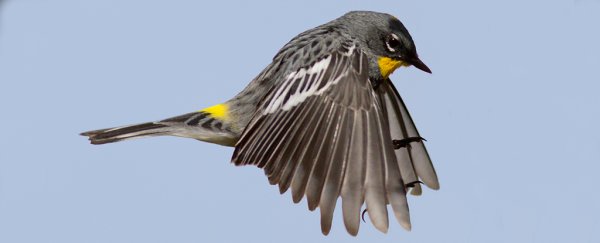Thanks to a combination of sensing the Earth's magnetic field through vision and an in-built compass that allows them to orient themselves according to magnetic intensity, migratory birds don't have much trouble finding their way.
Those biological gadgets, known as magnetoreception, allow birds to not only know which direction to head in on their first outbound migration but to know how to return to their nesting sites with extreme accuracy, often within meters of their original natal site.
To figure out how birds know when to stop, scientists investigated if birds may also be using cues from Earth's magnetic field to locate their breeding sites more accurately.
The cues could be the magnetic inclination – the dip angle between Earth's magnetic field and Earth's surface – or the magnetic intensity, the overall strength of Earth's magnetic field.
Earlier research suggested similar ideas as a means for birds to return to their desired flight paths if an extreme weather event had sent them off course.
The new study used data from 17,799 ringing recoveries (marked birds) from 1940 to 2018 to investigate if and how the Eurasian reed warbler (Acrocephalus scirpaceus), a trans-Saharan migratory songbird, used magnetic information to return to its nesting site.
If these birds actually use cues from Earth's magnetic field to locate their original breeding site, then the researchers reason that yearly variations in Earth's magnetic field should be reflected in gradual positional changes of the bird's nesting areas.
"Because Earth's magnetic field shifts slightly year by year, the magnetic parameter values characteristic of an individual's natal or breeding site will exist in a different location the following year," the authors explain.
"Hence, if birds used magnetic parameters to determine the location of their natal or breeding site, we would expect that positional changes between years would reflect year-on-year changes in the location of specific magnetic parameters."
Findings from the study point to magnetic inclination as the primary magnetic cue for the birds when relocating their breeding site, with specific inclination parameters signaling as a sort of 'stop sign'.
The authors suggest that the birds 'learn' the inclination angle before departing their breeding sites.
"We hypothesize that this is consistent with inclination acting as a uni-coordinate stop sign: Birds could recall their natal or breeding location using only one coordinate dimension, if used alongside a compass bearing linking the wintering and breeding sites," state the authors.
Using magnetic inclination as the primary cue for relocating their breeding site makes sense, according to the authors, because it has the most stable year-on-year variation compared to other potential magnetic cues. It provides migratory birds with a more reliable sign that they have reached a desirable location.
"Additionally, other magnetic gradient–derived positions move further with secular variation, which makes the proposed mechanism relatively robust. The position of the natal site as estimated using inclination and declination as a bicoordinate map would move, on average, 18.5 km (11.5 miles) between years; as estimated using intensity and declination, 20.4 km; and as estimated using intensity and inclination, 98.2 km," state the authors.
"By contrast, the location of the breeding site denoted using inclination as a stop sign moves only 1.22 km between years. We suggest that, by remembering breeding location relative to the most stable cue and referencing it alongside a compass bearing, the proposed strategy minimizes the impact of secular variation."
In fact, scientists found that birds recovered for use in the study closer to the site predicted by the inclination stop sign model than they were to their natal or breeding site, suggesting the birds may even prioritize the bio coordinate clues of magnetic inclination over even their breeding site.
Overall, it appears that by harnessing a number of biological mechanisms related to the parameters determined by Earth's magnetic field, migratory birds are able to successfully navigate and find the crucial environments needed for their continued survival.
The research was published in the journal Science.
